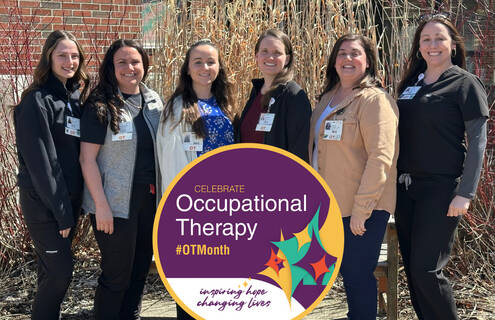
For the millions of people who suffer an illness, injury, or a condition that makes performing even the simplest tasks—say, brushing your teeth, signing your name, or tying your shoes—occupational therapy (OT) can be life changing.
A common misconception about OT is that it’s the same as physical therapy (PT). While both aim to improve quality of life, they differ in a few key ways:
- Physical therapy focuses on building and/or restoring strength and large motor skills, like walking and lifting.
- Occupational therapy addresses fine motor skills, particularly those key to daily living. This may include getting dressed, typing on a keyboard or phone, and using a knife or other utensils to eat.
With education and training in mental/behavioral health, medical conditions, rehabilitation, and lifestyle management, occupational therapists view patient needs in a unique context. Working with a patient’s physician, they develop treatment plans that address physical needs, but also consider aspects of the patient’s life, including employment and family role.
Common goals for OT include:
- Increasing independence and improving quality of life
- Enabling a safe return to work
- Adapting environments and tasks to make them accessible
- Regaining, developing, or maintaining daily living skills
How OT can work for you
How SVCM's OT team helped in 2024
Top 5 conditions treated for adults:
- Upper extremity fractures
- Arthritis
- Repetitive stress injuries (for example, carpal tunnel syndrome, tennis/golfer’s elbow)
- Post-stroke
- Nerve-related injuries
Top 5 conditions treated for children:
- Developmental delays
- Sensory processing disorder
- Fine motor delays
- Movement and coordination impairments
- Autism spectrum disorder
Occupational therapy can help you participate in life activities (occupations) and tend to focus on:
- Activities of daily living (such as bathing, dressing, and eating)
- Adaptive equipment (such as shower chairs, or equipment to make daily tasks easier)
- Caregiver and family training
- Planning and making the most of daily routines
- Returning to work, school, and leisure activities
- Techniques to aid in memory, concentration, and executive functioning (for example, planning and prioritizing, functional cognition)
- Fall prevention and home safety and accessibility
OT @ SVMC
Many patients are referred to OT by their doctor, but others are directed to it after surgery or being seen in the Emergency Department or ExpressCare.
Regardless of how they arrive, the OT experience typically includes:
- A personal evaluation/occupational profile, that documents a patient’s history, life experiences, interests, and what activities are important to them
- An intervention plan customized to the specific condition, goals, and designed to improve one’s ability to perform daily activities
- An outcomes evaluation to ensure goals are being met
- A customized home-exercise plan and education program
SVMC occupational therapy team members
- Brittany Briggs, MSOT, OTR/L
- Gabe Borman, MOT, OTR/L
- Lauren Conigliaro OTD, OTR/L
- Gabrielle Loomis, MSOT, OTR/L
- Kendra Petro, OTD, OTR/L, CLT
- Whitney Shepperd, MEd, OTR/L, CLT
- Michaelia St. Jacques, MSOT, OTR/L, CHT
- Colleen Thorpe, MSOT, OTR/L
While based at the hospital, SVMC’s team of eight therapists provide inpatient and outpatient services for people of all ages at the following locations:
- SVMC Northshire Campus, outpatient adult OT services
- SVMC Deerfield Valley Health Campus, outpatient adult OT services
- Southwestern Vermont Medical Center, outpatient adult and pediatric as well as inpatient OT services
- The Dartmouth Cancer Center at Southwestern Vermont Medical Center, cancer-related fatigue education
Regardless of where OT is provided, the end goal is the same: enabling people of all ages to participate fully in their daily lives.